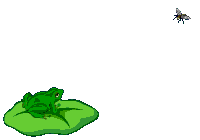

![]()
A tropical rainforest consists of three layers of life: the canopy, the understory and the forest floor. There is also something called the Emergent layer in which trees grow higher then other trees. There are only one or two in every few acres of rain forest.
The canopy is in the treetops (160-220 feet tall!) which make up the rainforest's green ceiling. The canopy of the rain forest blocks out much of the sun's rays from the lower levels of the rain forest. Many of the plants that grow there we also have in the U.S., such as: prayer plants and philodendron. These plants like the warm, dark places and grow well indoors. Most of the animals of the rainforest such as monkeys, birds, tree frogs and even snakes, live in the canopy.

The understory is home to hundreds of thousands of interesting plants and animals. The forest floor is the bottom layer of the rainforest. Except for rotting vegetation which nourishes the thin tropical soil, the forest floor is almost bare. Large mammals like jaguars and African gorillas live on the forest floor.
The list of plants and animals found in the understory is endless. Scientists look forward to discovering and learning more. This will only be possible if the destruction of the rain forest can be halted in the future!
On the Forest floor, soil quality is very poor. Except along the banks of the rivers. There is little light and plant debris rarely falls to the ground.
Rainforests help control our world's climate. It rains a lot in the rain forest and is very hot. A water cycle of sorts takes place by the evaporation of the rainwater back into the air. Rainwater in the Amazon can be recycled five to seven times. Some 50% of rain in some of the rain forests comes from evaporation. The clouds cover the rain forests around the equator reflect the sun. This keeps the rain forest from getting too hot.
